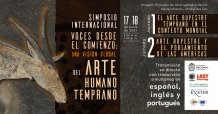
The online international symposium is run by academics from the University of Exeter’s ERC Last Journey project, in partnership with the Colombian Institute of Anthropology and History (ICANH), Universidad de Antioquia and Universidad Nacional de Colombia.
Major discoveries about rock art across the world showcased at research symposium
Experts will showcase incredible discoveries about rock art around the globe at a symposium this week.
Researchers are carrying out studies to show how this earliest artistic expression of humans gives a glimpse into how communities thousands of years ago sought to navigate and understand their place in the world.
Academics will explain how the images record ancient views about cosmology, social traditions and human relationships with nature.
The online international symposium is run by academics from the University of Exeter’s ERC Last Journey project, in partnership with the Colombian Institute of Anthropology and History (ICANH), Universidad de Antioquia and Universidad Nacional de Colombia. It will take place on 17 and 18 June.
Archaeological research conducted by the University of Exeter’s Last Journey project has confirmed the origins of the paintings in the Serranía La Lindosa, in the Colombian Amazon to 12,600 years before the present. The pictures depict human figures, hunting scenes, dances and ceremonies, handprints, plants, abstract geometric designs and multiple animals, including what appear to be extinct Ice Age animals. They are some of the earliest artistic expressions of native Amazonians and hold great potential for understanding early human interaction with the landscape and the development of the unique Amazonian cultures and worldviews.
There will also be discussion about Aboriginal rock art, showing how researchers are working with Aboriginal people in Australia’s northwest to better understand this amazing national treasure. Experts will also explain how new management regimes in Indigenous Protected Areas and co-managed National Parks are providing the platforms for sustainable new economies for Aboriginal people working with rock art.
There will also be a presentation about the chronological and geographical diversity of Siberian rock art, about new research to date the hunter-gatherer rock art of South Africa’s Drakensberg mountains and about the spectacular paintings found in the Altamira cave in Spain.
University of Exeter experts will present their research on the megafauna depictions in the rock art of Serranía de La Lindosa, which includes giant sloth, a gomphothere, a camelid, horses, and three-toed ungulates with trunks, now thought to be from from the Ice Age. The drawings may contain early European visitors to the region in the 16th century, and war dogs used by them as a weapon of torture and terror. The drawings also show the biodiversity of the ancient Amazon, showing species present 20,000 years ago now extinct.
Another presentation will show how archaeological sites near Monte Alegre, along Brazil's lower Amazon River, shows new information about the little-known activities of South American Paleoindians toward the end of the Ice Age. Early settlers of Monte Alegre painted rock art on the landscape, which bears a record of the sun's horizon positions throughout the year. Their painted grid of tally marks might have served as a rudimentary early calendar.
To coincide with the event a new publication, “Voices from the beginning: A global view of early human art”, will be published.
The symposium, 'Voices from the beginning: A global view of early human art', will be held on June 17 to 18 (9-11 am Bogota; 11 am -15 pm Brasilia; 3-7 pm BST). It will be broadcasted live with translations English-Spanish-Portuguese on the following channels:
English: Zoom - please register here. Limited places available.
Spanish: Tune YouTube Channel ICANH
Portuguese: Tune YouTube Audiovisuales Channel ICANH
Please check the detailed programme in Spanish and English.
More information on the ICANH website.
Date: 18 June 2021
